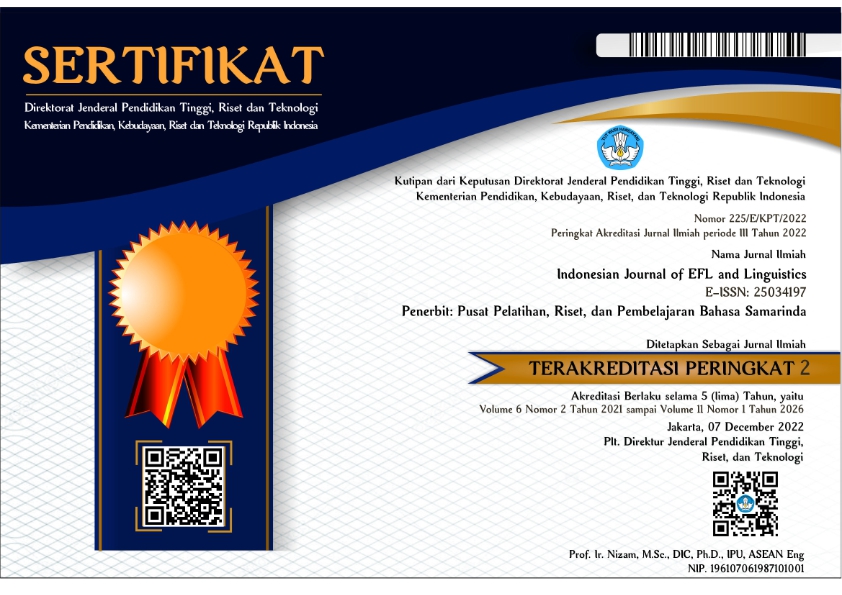Variations of Malay Language in Sintang Raya
Abstract
The research area in this study includes 1) a description of word variations, 2) differences in word variations between locations; (3) a language variation map, 4) language variation isogloss files. There are two methods used, namely descriptive and comparative methods. The descriptive method uses quantitative and qualitative techniques. The comparative method uses synchronous techniques. The comparative method is used to compare word variations in the research location. The calculation of the difference in word variations uses dialectometric formulas. The separation of language variations in the research location uses isogloss files. The results of the data analysis are 1) a description of the variations of the Malay language in 12 research locations; 2) the least difference in word variations in research locations 9-11 = 24 and the most difference in word variations in research locations 1-4 = 59; 3) based on the data analysis, the variations of words in the research locations resulted in different speech, sub-dialects, and dialects; 4) the linguistic distance in percentage is the least 24% in area 9-11 and the linguistic distance in percentage is the most 59% in research locations 1-4; 5) the map of word variations of the Malay language in Sintang Raya has 3 dialects; 6) the isogloss files show the existence of the most language variations as a separator of research has 3 dialects.
References
Bosch, A. R. K. (2006). Scottish Gaelic Dialectology: A Preliminary Assessment of The Survey of The Gaelic of Scotland. Lingua, 116(2006), 2012–2022.
Chaoju, T. & Heuven, V.J.V. (2009). Mutual Intelligibility of Chinese Dialects Experimentally Tested. LINGUA: 119 (2009) (709-732). www.elsevier.com/locate/lingua
Clopper, C. G., & Pisoni, D. B. (2004). Some Acoustic Cues for The Perceptual Categorization of American English Regional Dialects. Journal Of Phonetics, 32(2004), 111–140.
Crowley, T, Bowern, C. (2010). An introduction to historical linguistics. University Press Inc.
Hamid, N.A., dkk. (2022). Malay Dialect Variants in Langkawi: A Diachronic Perspective Analysis. Journal of Nusantara Studies (JONUS): 7(1) 142-167. Journal.uniza.edu.my
Hasrah, M.T. (2018). Dialek Melayu Hulu dan Hilir di Timur Semenanjung Malaysia. Jurnal Bahasa: 18(1) 65-102.
Heeringa, W., Johnson, K., Gooskens, C. (2009). Measuring Norwegian Dialect Distances Using Acoustic Features. Speech Communication: 51 (2009) 167-183. www.elsevier.com/locate/specom
Jalaluddin, N.H. (2018). Dialek Melayu di Perak: Analisis Geolinguistik. International Journal of the Malay World and Civilisation: 6(2) 69-82.
Jalaluddin, N. H., Fazal, M., Sultan, M., & Khairul, H. R. (2019). Making Pittsburghese: Communication Technology, Expertise, and The Discursive Construction of a Regional Dialect. Journal Of Nusantara Studies (JONUS), 4(2), 362–389.
Johnstone, B. (2011). Making Pittsburghese: Communication Technology, Expertise, and The Discursive Construction of a Regional Dialect. Language And Communication: 31 (2011) 3-15. www.elsevier.com/locate/langcom
Jubaidah, S. (2020). Dialek Betawi Jakarta. Tsaqofah: 18(1) 1-11.
Kisyani, L., & Savitri, D.A. (2009). Dialektologi. Unesa University Press.
Kurniadi, D. (2020). Distinctive Dialect Caused by Regional Borders on “Srinahan†Societi As Javanese Speakers. Philosophica: Jurnal Bahasa dan Sastra, dan Budaya: 3(2) 56-64.
Mahsun. (2010). Genolinguistik. Pustaka Pelajar.
Nadra, & Reniwati. (2009). Dialektologi: Teori dan metode. Elmatera Publishing.
Patriantoro, Sumarlam, dan Fernandes, Y.I. (2012). Dialektologi Bahasa Melayu di pesisir Kabupaten Bengkayang. Kajian Linguistik dan Sastra, Vol 24, No 1, Juni 2012.
Patriantoro. (2012). Dialektologi Bahasa Melayu di pesisir Kabupaten Pontianak. Dalam Widyaparwa, Jurnal Ilmiah Kebahasaan dan Kesastraan. Volume 40, Nomor 2, Desember 2012.
Patriantoro. (2015). Geografi Dialek Bahasa Melayu di daerah aliran Sungai Sambas dan Mempawah Kalimantan Barat. Universitas Gadjah Mada Yogyakarta.
Patriantoro. (2017). Dialektologi Bahasa Melayu di Kabupaten Kubu Raya. Fenolingua, Tahun 25, Nomor 1.
Patriantoro. (2017). Dialektologi Bahasa Melayu di Bagian Tengah aliran Sungai Kapuas Meliputi Kabupaten Sanggau dan Sekadau Kalimantan Barat. Magistra, Tahun XXIX No 100.
Patriantoro. (2021). The geography of Dayak Dialect in Landak Regency, West Kalimantan. Indonesia Journal of EFL and Linguistics, 6 (1), 2021. https://www.indonesian-elf-journal.org/index.php/ijefll/issue/view/28
Patriantoro. (2021). Geografi Dialek Bahasa Melayu di Sambas Raya Kalimantan Barat. FKIP Universitas Tanjungpura Pontianak.
Patriantoro. (2022). The Geography of The Malay Dialect in Kapuas Hulu Regency West Kalimantan. Journal of English Language Teaching and Linguistics, 7(1).
Rahayu, I. M. (2018). Variasi Dialek Bahasa Jawa di Kabupaten Ngawi: Kajian Dialektologi. Jurnal Unair.
Ratnasari, A., Arniati, I., & Kurniadi, D. (2022). The Differences of Pati and Kudus Dialect: Dialectological Studies. Surakarta English and Literature Journal, 5(1), 49–58.
Rozelin, D. & Fauzan, U. (2020). Education and Proto Language Maintenance at Orang Rimba In Jambi. Indonesian Journal of English Language Teaching and Applied Linguistics, 5(1), 177–189.
Saddhono, K. & Hartanto, W. (2021). A Dialect Geography in Yogyakarta-Surakarta Isolect in Wedi District: An Examination of Permutation and Phonological Dialectometry as an Endeavor to preserve Javanese Language in Indonesia. Heliyon: 7(7).
Sholeha, M. & Kumoro, H. (2022). Kekerabatan Bahasa Kerinci, Melayu Jambi, dan Minangkabau. Diglosia: Jurnal Kajian Bahasa, Sastra, dan Pengajarannya: 5(2) 399-420.
Soukup, B., Broumuler, & Vienna. (2011). Dialect Use as Interaction Strategy. A Sociolinguistic Study of Contextualization, Speech Perception, and Language Attitudes in Austria. Journal Of Pragmatics: 43 (2011)2272-2274. www.elsevier.com/locate/pragma
Straw, M. & Patrick, P.L. (2007). Dialect Acquisition of Glottal Variation in /t/: Barbadians in Ispich. Language Sciences: 29 (2007) 385-407. www.elsevir.com/locate/langsci
Subroto, E. D. (2011). Pengantar studi semantik dan pragmatik. Cakrawala Media.
Sudaryanto. (1993). Metode dan aneka teknik analisis bahasa. Duta Wacana University Press.
Teerarojanarat, S. & Tingsabadh, K. (2011). Using GIS for Linguistics Study: a Case of Dialect Change in The Northeastern Region of Thailand. Procedia Social And Behavioral Sciences: 21 (2011) 362-371. www.sciencedirect.com
Tiani, R. (2018). Bentuk Pergeseran Dialek pada Masyarakat Betawi. Jurnal Ilmu Bahasa dan Sastra. Download.garuda.kemendikbud.go.id
Verhaar, J. W. M. (2008). Azas-Azas Linguistik Umum. Gadjah Mada University Press.
Wariyati, A. (2018). Lexical Cjange Causes of Javanese Language in Deli Serdang Regency. Jurnal Penelitian Pendidikan. Jurnal-LP2M.umnaw.ac.id
Wieling, M. & Nerbonne, J. (2011). Bipartite Spectral Graph Partitioning for Clustering Dialect Varieties and Dedecting Their Linguistik Features. Computer Speech And Language: 25 (2011) 700-715. www.elseviercom/locate/csl
Copyright (c) 2023 Indonesian Journal of EFL and Linguistics

This work is licensed under a Creative Commons Attribution-NonCommercial-ShareAlike 4.0 International License.




